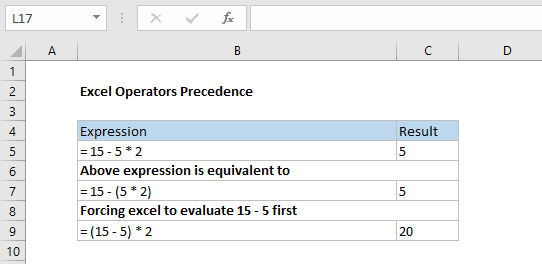Excel - Operators Precedence
Excel Operators Precedence
Operator precedence (order of operations) is a collection of rules that reflect conventions about which procedures to perform first in order to evaluate a given expression.
For example, multiplication has higher precedence than addition. Thus, the expression 1 + 2 × 3 is interpreted to have the value 1 + (2 × 3) = 7, and not (1 + 2) × 3 = 9. When exponent is used in the expression, it has precedence over both addition and multiplication. Thus 3 + 52 = 28 and 3 × 52 = 75.
The example below illustrates the operator precedence in Excel.

Excel Operators Precedence Table
The following table lists the precedence of Excel operators. Operators are listed top to bottom, in descending precedence. Operators with higher precedence are evaluated before operators with relatively lower precedence. Excel calculates the formula from left to right, according to a specific order for each operator in the formula.
| 9 | () | Parentheses |
| 8 | : | Less than, Less than or equal, Greater than, and Greater than or equal |
| (space) | Equal to | |
| , | Not equal to | |
| 7 | - | Negation |
| 6 | % | Percent |
| 5 | ^ | Exponentiation |
| 4 | * / | Multiplication, Division |
| 3 | + - | Addition, Subtraction |
| 2 | & | Connects two strings of text (concatenation) |
| 1 | < <= > >= | Less than, Less than or equal, Greater than, and Greater than or equal |
| = | Equal to | |
| <> | Not equal to |
❮ Excel - Operators


